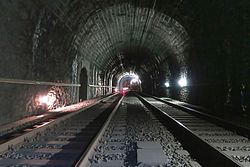Our website is made possible by displaying online advertisements to our visitors.
Please consider supporting us by disabling your ad blocker.
Gotthard Tunnel
 Inside the tunnel | |
| Overview | |
|---|---|
| Official name | German: Gotthardtunnel, Italian: Galleria del San Gottardo |
| Line | Gotthard Line |
| Location | Traversing the Saint-Gotthard Massif in the middle of the Swiss Alps |
| Coordinates | 46°35′44″N 8°35′44″E / 46.59556°N 8.59556°E |
| System | Swiss Federal Railways (SBB CFF FFS) |
| Start | Göschenen, canton of Uri (north, 1,106 m or 3,629 ft) |
| End | Airolo, canton of Ticino (south, 1,145 m or 3,757 ft) |
| Operation | |
| Work begun | September 13, 1872 |
| Opened | June 1, 1882[1] |
| Owner | SBB CFF FFS |
| Operator | SBB Infrastructure |
| Traffic | railway |
| Character | passenger, freight |
| Technical | |
| Design engineer | Louis Favre |
| Length | 15,002.64 m (9.32221 mi)[1] |
| No. of tracks | Double |
| Track gauge | 1,435 mm (4 ft 8+1⁄2 in) (standard gauge) |
| Electrified | 15 kV 16.7 Hz since September 18, 1920[1] |
| Highest elevation | 1,151 m (3,776 ft) (inside the tunnel) |
| Lowest elevation | 1,106 m (3,629 ft) (north portal) |
| Tunnel clearance | 7.1 m (23 ft 4 in) |
| Width | 8.0 m (26 ft 3 in) |
| Route map | |
 | |
The Gotthard Tunnel (German: Gotthardtunnel, Italian: Galleria del San Gottardo) is a 15-kilometre-long (9.3 mi) railway tunnel that forms the summit of the Gotthard Railway in Switzerland. It connects Göschenen with Airolo and was the first tunnel through the Saint-Gotthard Massif in order to bypass the St Gotthard Pass. It was built as single bore tunnel accommodating a standard gauge double-track railway throughout.[2] When opened in 1882, the Gotthard Tunnel was the longest tunnel in the world.
The tunnel rises from the northern portal at Göschenen (1,106 m or 3,629 ft) and the highest point (1,151 m or 3,776 ft) is reached after approximately eight kilometres (5 mi). After two more kilometers, the border between the cantons of Uri and Ticino is passed; after another five kilometres (3 mi), the tunnel ends at the southern portal near to Airolo (1,142 m or 3,747 ft). The trip takes about seven to eight minutes by train. Services are operated by the Swiss Federal Railways.
- ^ a b c "75 years of the Gotthard railway (to be continued)". The Swiss Observer. 42 (1303). London, UK: 8976. 30 August 1957. doi:10.5169/seals-691663.
15,002.64m
- ^ Eisenbahnatlas Schweiz. Verlag Schweers + Wall GmbH. 2012. p. 34. ISBN 978-3-89494-130-7.
Previous Page Next Page


